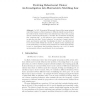Free Online Productivity Tools
i2Speak
i2Symbol
i2OCR
iTex2Img
iWeb2Print
iWeb2Shot
i2Type
iPdf2Split
iPdf2Merge
i2Bopomofo
i2Arabic
i2Style
i2Image
i2PDF
iLatex2Rtf
Sci2ools
ECAL
1999
Springer
1999
Springer
Evolving Behavioural Choice: An Investigation into Herrnstein's Matching Law
In 1961, Herrnstein [4] famously observed that many animals match the frequency of their response to different stimuli in proportion to the reinforcement obtained from each stimulus type. Since then, a great deal of research has attempted to elucidate the mechanisms underlying this “matching law”, so far without a clear consensus emerging. Here, we take the view that “choice behaviour” is a product of agent, environment, and observer, and that “mechanisms of choice” are therefore not to be located solely within the chooser. A simple model, employing the novel methodology of evolving choice behaviour in a multi-agent system, is used to demonstrate that matching behaviour can occur (in stable environments) without any dedicated choice mechanism.
| Added | 04 Aug 2010 |
| Updated | 04 Aug 2010 |
| Type | Conference |
| Year | 1999 |
| Where | ECAL |
| Authors | Anil K. Seth |
Comments (0)

